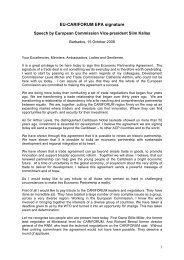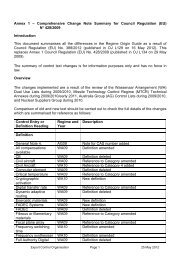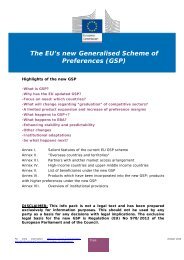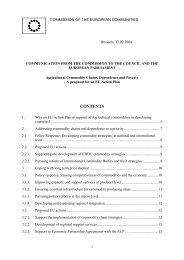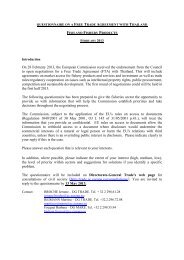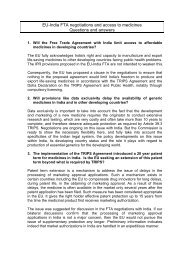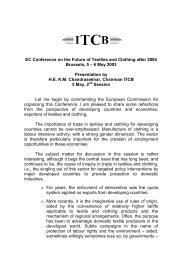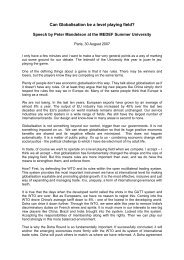Report on the Implementation of the derogation to ... - Trade Websites
Report on the Implementation of the derogation to ... - Trade Websites
Report on the Implementation of the derogation to ... - Trade Websites
Create successful ePaper yourself
Turn your PDF publications into a flip-book with our unique Google optimized e-Paper software.
Final <str<strong>on</strong>g>Report</str<strong>on</strong>g><br />
RoO Derogati<strong>on</strong> under <strong>the</strong> PACP-IEPA<br />
between 2006 (a record high) and 2010. MW Brands/Thai Uni<strong>on</strong> partly countered this supply<br />
c<strong>on</strong>straint by shifting producti<strong>on</strong> <strong>to</strong> its cannery in Ghana, which increased its exports <strong>to</strong> <strong>the</strong><br />
EU by 25% between 2006 and 2010. 300 The o<strong>the</strong>r processors based in Ghana are locallyowned<br />
but are minor players in comparis<strong>on</strong>.<br />
• Mauritius has steadily increased its share <strong>of</strong> <strong>the</strong> EU market through producti<strong>on</strong> increases by<br />
Princes Tuna Mauritius and Th<strong>on</strong> des Mascareignes. In <strong>the</strong> last five years (2006-10) Mauritius<br />
has increased its canned tuna exports <strong>to</strong> <strong>the</strong> EU by 17%. Princes Tuna Mauritius is <strong>the</strong> largest<br />
processor <strong>the</strong>re and produces canned tuna in vegetable oil and in brine for Mitsubishi’s<br />
Princes subsidiary, but it also supplies private label <strong>to</strong> EU clients. Th<strong>on</strong> de Mascareignes has<br />
transformed from being primarily a producer <strong>of</strong> loins <strong>to</strong> a significant cannery. Mauritius also<br />
emerged in 2010 as <strong>the</strong> sec<strong>on</strong>d largest supplier <strong>of</strong> loins <strong>to</strong> <strong>the</strong> EU with 12% volume share<br />
(Table 6.3). To ensure supply, <strong>the</strong>se processing facilities <strong>of</strong>ten pay slightly higher raw<br />
material prices than <strong>the</strong> cannery in Seychelles and were <strong>the</strong>reby able <strong>to</strong> increase producti<strong>on</strong><br />
ra<strong>the</strong>r than follow Seychelles’ recent decline.<br />
• Ecuador is resp<strong>on</strong>sible for over half <strong>of</strong> tuna processing across <strong>the</strong> eastern Pacific and is <strong>the</strong><br />
major player in canned tuna processing in <strong>the</strong> Americas. There are approximately 18<br />
processing plants located in Guayaquil, Posorja and Manta with a daily processing capacity<br />
ranging from <strong>on</strong>ly 20 mt/day up <strong>to</strong> 300 mt/day. 301 Producti<strong>on</strong> in Ecuador can be split by a<br />
minority <strong>of</strong> subsidiaries <strong>of</strong> Spanish branded-firms and a majority <strong>of</strong> domestically-owned,<br />
specialised n<strong>on</strong>-branded processors. The first major Spanish investment in Ecuador was by<br />
Garavilla in 1976. The next Spanish firm <strong>to</strong> invest <strong>the</strong>re – Albacora – came over two decades<br />
later in 2000. With Thailand, Ecuador dominates <strong>the</strong> US market for tuna pouches. For<br />
Ecuador this was <strong>the</strong> outcome <strong>of</strong> a US trade preference for this particular product type. 302<br />
Ecuador is also <strong>the</strong> leader in <strong>the</strong> EU import market for loins (Table 6.3). 303 Processors in<br />
Ecuador can also be fur<strong>the</strong>r typified by those that are backward integrated in<strong>to</strong> fishing<br />
(which includes <strong>the</strong> Albacora and Garavilla) and those that are not. Given that Ecuador<br />
needs <strong>to</strong> import around 100,000 mt <strong>of</strong> its raw material needs each year, vertical-integrati<strong>on</strong><br />
is a major strategy for ensuring supply <strong>of</strong> tuna. Between January and early August 2010, over<br />
80,000 mt <strong>of</strong> tuna were imported in<strong>to</strong> Eastern Pacific producti<strong>on</strong> sites. Of this, around<br />
72,000 mt was delivered <strong>to</strong> Ecuador. In 2010, over 89% <strong>of</strong> raw material imports <strong>to</strong> <strong>the</strong><br />
Eastern Pacific regi<strong>on</strong> originated in <strong>the</strong> WCPO. 304<br />
• Between 2005 and 2007, Thunnus Overseas Group (TOG) c<strong>on</strong>solidated its operati<strong>on</strong>s across<br />
two fac<strong>to</strong>ries in Côte d'Ivoire and a single fac<strong>to</strong>ry in Madagascar <strong>to</strong> increase producti<strong>on</strong> and<br />
reduce costs (see Table 6.9). However, <strong>the</strong>se two producti<strong>on</strong> locati<strong>on</strong>s each saw <strong>the</strong>ir share<br />
<strong>of</strong> <strong>the</strong> EU market decline by around 50% between 2000 and 2009. Political crises in <strong>the</strong><br />
2000s in both countries may have c<strong>on</strong>tributed <strong>to</strong> producti<strong>on</strong> declines. All <strong>of</strong> <strong>the</strong>se fac<strong>to</strong>ries<br />
specialise in <strong>the</strong> n<strong>on</strong>-branded processing <strong>of</strong> basic canned tuna and thus compete in a similar<br />
market segment <strong>to</strong> PNG (see Secti<strong>on</strong> 6.7.4).<br />
300 This was a result <strong>of</strong> shifting exports <strong>to</strong> <strong>the</strong> EU away from this fac<strong>to</strong>ry’s o<strong>the</strong>r market, <strong>the</strong> United States.<br />
301 Hamilt<strong>on</strong> et al. 2011.<br />
302 For relevant details <strong>on</strong> <strong>the</strong> Andean <strong>Trade</strong> Preference Act and related US preferential arrangements, see<br />
Campling et al. 2007.<br />
303 It was also a major supplier <strong>of</strong> loins <strong>to</strong> <strong>the</strong> US in <strong>the</strong> early 2000s, but this had declined <strong>to</strong> insignificant<br />
volumes by 2007.<br />
304 Hamilt<strong>on</strong> et al. 2011. See also Table 6.16 below.<br />
Linpico s.a.r.l. Page 147




